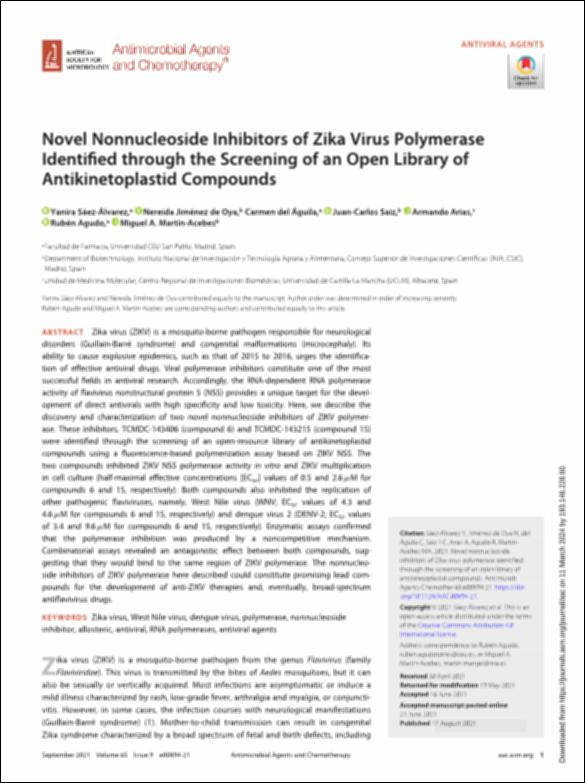Por favor, use este identificador para citar o enlazar este ítem:
http://hdl.handle.net/10637/15655Novel nonnucleoside inhibitors of Zika Virus polymerase Identified through the screening of an open library of antikinetoplastid compounds
| Título : | Novel nonnucleoside inhibitors of Zika Virus polymerase Identified through the screening of an open library of antikinetoplastid compounds |
| Autor : | Sáez Álvarez, Yanira Jiménez de Oya, Nereida Del Águila, Carmen Sáiz, Juan Carlos Arias, Armando Agudo Torres, Rubén Martín Acebes, Miguel A. |
| Materias: | Zika virus; West Nile virus; Dengue virus; Polymerase; Nonnucleoside inhibitor; Allosteric; Antiviral; RNA polymerases; Antiviral agents |
| Editorial : | American Society for Microbiology |
| Citación : | Sáez-Álvarez Y, Jiménez de Oya N, del Águila C, Saiz J-C, Arias A, Agudo R, Martín- Acebes MA. 2021. Novel nonnucleoside inhibitors of Zika virus polymerase identified through the screening of an open library of antikinetoplastid compounds. Antimicrob Agents Chemother 65:e00894-21. https://doi .org/10.1128/AAC.00894-21. |
| Resumen : | Zika virus (ZIKV) is a mosquito-borne pathogen responsible for neurological disorders (Guillain-Barré syndrome) and congenital malformations (microcephaly). Its ability to cause explosive epidemics, such as that of 2015 to 2016, urges the identification of effective antiviral drugs. Viral polymerase inhibitors constitute one of the most successful fields in antiviral research. Accordingly, the RNA-dependent RNA polymerase activity of flavivirus nonstructural protein 5 (NS5) provides a unique target for the development of direct antivirals with high specificity and low toxicity. Here, we describe the discovery and characterization of two novel nonnucleoside inhibitors of ZIKV polymerase. These inhibitors, TCMDC-143406 (compound 6) and TCMDC-143215 (compound 15) were identified through the screening of an open-resource library of antikinetoplastid compounds using a fluorescence-based polymerization assay based on ZIKV NS5. The two compounds inhibited ZIKV NS5 polymerase activity in vitro and ZIKV multiplication in cell culture (half-maximal effective concentrations [EC50] values of 0.5 and 2.6mM for compounds 6 and 15, respectively). Both compounds also inhibited the replication of other pathogenic flaviviruses, namely, West Nile virus (WNV; EC50 values of 4.3 and 4.6mM for compounds 6 and 15, respectively) and dengue virus 2 (DENV-2; EC50 values of 3.4 and 9.6mM for compounds 6 and 15, respectively). Enzymatic assays confirmed that the polymerase inhibition was produced by a noncompetitive mechanism. Combinatorial assays revealed an antagonistic effect between both compounds, suggesting that they would bind to the same region of ZIKV polymerase. The nonnucleoside inhibitors of ZIKV polymerase here described could constitute promising lead compounds for the development of anti-ZIKV therapies and, eventually, broad-spectrum antiflavivirus drugs. |
| URI : | http://hdl.handle.net/10637/15655 |
| Derechos: | http://creativecommons.org/licenses/by-nc-nd/4.0/deed.es |
| ISSN : | 1098-6596 |
| Fecha de publicación : | 17-ago-2021 |
| Centro : | Universidad San Pablo-CEU |
| Aparece en las colecciones: | Facultad de Farmacia |
Los ítems de DSpace están protegidos por copyright, con todos los derechos reservados, a menos que se indique lo contrario.


